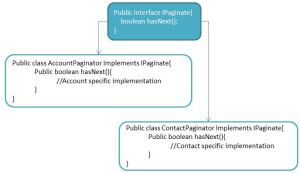While designing any solution, we often spend good amount of time preparing coding standards, guidelines, best practices, etc… The idea behind such effort is to make sure that the chosen design is implemented with ease and quality work is delivered. Having a good design can have a profound influence on success of any implementation.
A good design needs to be robust and scalable. The code should be structured and reusable. There is no place for redundant code in a good design. Hence it is very important to understand different ways by which we can write less and reusable code.
By using Abstract classes and Interfaces developers can design robust and scalable solutions.
Are TAs expected to write classes and interfaces?
Yes in some cases and no in most cases 🙂 Even if you (as a TA) are not writing code, then you are expected to
- Have a clear understanding of how Abstract classes and Interfaces can be leveraged for a good design?
- Guide the development teams to a right design approach. If needed, teach them how to work with abstract classes and interfaces.
What is an Abstract Class?
An abstract class is just like any other class, having properties and methods. However it has following characteristic which makes it different from other classes.
- It can have executable methods and abstract methods.
- It can only subclass one abstract class.
- It cannot be instantiated.
- It can only be extended by other classes (called subclasses).
- Its abstract methods must be overridden by its subclasses.
- Its non-abstract methods cannot be overridden by its subclasses.
An example abstract class
public abstract class MasterDataHandler{
//executable method
public MasterDataService initMasterDataService(){
MasterDataService objMasterDataService = new MasterDataService();
/**
your code goes here....
**/
return objMasterDataService;
}
//abstract method, which should be overridden by extending class.
public abstract Boolean doSynch();
}
Examples of extending classes (sub classes)
public class AccountSynchHelper extends MasterDataHandler{
public override boolean doSynch(){
return true;
}
}
public class ContactSynchHelper extends MasterDataHandler{
public override boolean doSynch(){
return true;
}
}
What is an Interface?
An interface is like a class in which none of the methods have been implemented—the method signatures are there, but the body of each method is empty. To use an interface, another class must implement it by providing a body for all of the methods contained in the interface. Interface has following attributes that makes it different from abstract classes.
- It has no implementation code.

- All its methods are abstract by default.
- A class can implement any number of interfaces.
- An interface can extend another interface.
- As with classes, when an interface extends another interface, all the methods and properties of the extended interface are available to the extending interface.
Please refer below links for more information
http://www.salesforce.com/us/developer/docs/apexcode/Content/apex_classes_defining.htm
http://www.salesforce.com/us/developer/docs/apexcode/Content/apex_classes_interfaces.htm
Hope that’s helpful.
